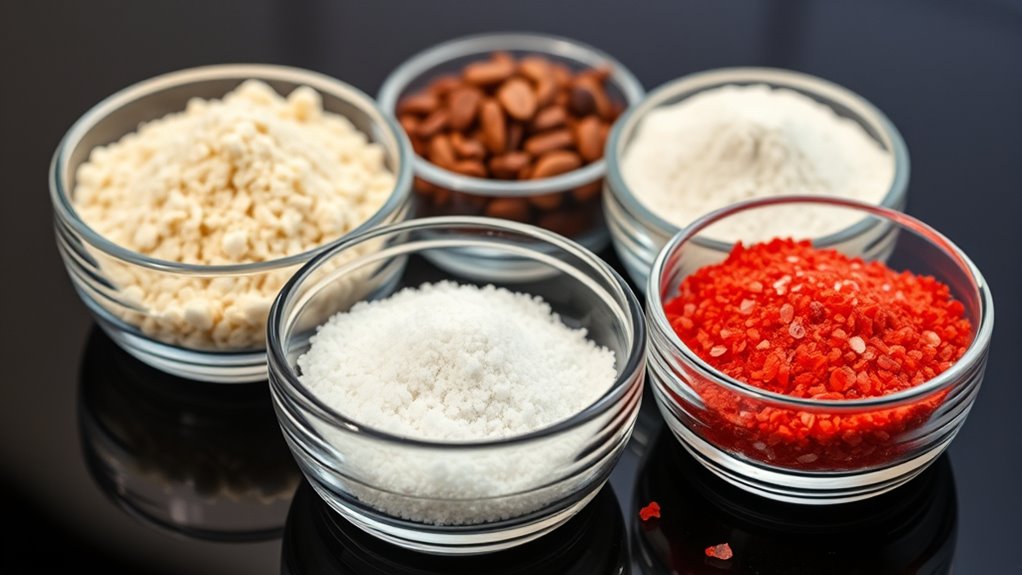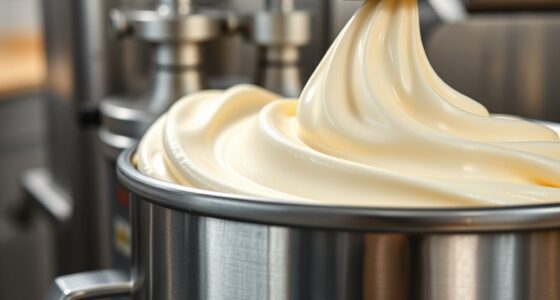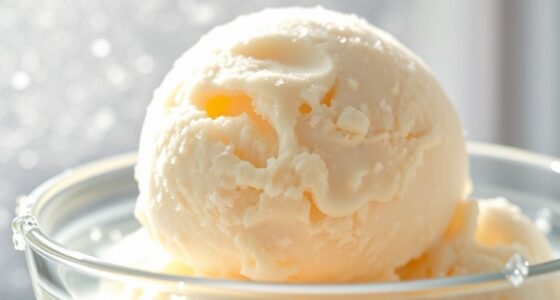Stabilizers and gums like guar, locust bean, xanthan, and carrageenan help you keep food products uniform and appealing. Guar and locust bean add thickness and improve texture, especially in gluten-free baking and dairy items. Xanthan stabilizes beverages without affecting flavor, while carrageenan enhances creaminess in dairy and plant-based drinks. If you continue exploring, you’ll discover how these natural ingredients boost product quality and meet modern consumer demands.
Key Takeaways
- Guar, locust bean, xanthan, and carrageenan are natural gums used as stabilizers and thickeners in various foods.
- Guar and locust bean gums improve texture and stability, especially in dairy and baked goods.
- Xanthan gum is effective in small quantities for suspending and thickening beverages without affecting flavor.
- Carrageenan enhances creaminess and prevents separation in dairy and plant-based drinks.
- These natural gums support clean-label, health-conscious, and plant-based food product formulations.

Have you ever wondered how food and beverages maintain their texture and consistency? It’s all about the clever use of stabilizers and gums, which serve vital food additive functions. These ingredients help keep products uniform, prevent separation, and improve mouthfeel. When you pick up a jar of jam or a carton of plant-based milk, chances are these stabilizers and gums are working behind the scenes to give you the perfect experience. Among the most common are guar gum, locust bean gum, xanthan gum, and carrageenan — each with unique properties that suit different applications.
You might be surprised to learn that many of these gums are natural alternative gums, derived from plants and microorganisms. Guar gum, for example, comes from guar beans and acts as a thickening and stabilizing agent. It’s popular in gluten-free baking and dairy products because it enhances viscosity without altering flavor. Locust bean gum, extracted from carob tree seeds, is often combined with other gums to improve texture and stability, especially in ice creams and sauces. Xanthan gum, produced through fermentation of sugars by bacteria, is highly effective in small amounts, providing thickening and suspension without adding weight or flavor. Carrageenan, extracted from red seaweed, is widely used in dairy and plant-based drinks to prevent separation and improve mouthfeel.
These stabilizers and gums aren’t just functional; they also offer a healthier alternative to synthetic thickeners and stabilize agents. Natural alternative gums are favored in organic and clean-label products because they come from renewable, plant-based sources. They’re safe when used within recommended levels and often recognized for their minimal impact on health. As a consumer, you benefit from these natural ingredients because they allow food manufacturers to create products with better texture, longer shelf life, and improved appearance without relying on artificial additives.
Natural gums offer healthier, plant-based alternatives that improve texture and shelf life without artificial additives.
Understanding food additive functions helps you make more informed choices. Gums like guar and locust bean can improve the viscosity of dressings, sauces, and dairy products, while xanthan provides excellent stability in beverages and gluten-free baked goods. Carrageenan enhances creaminess in dairy-like drinks and desserts. When you see these ingredients on labels, know that they’re there to guarantee your food remains appealing, consistent, and enjoyable. The move toward natural alternative gums reflects a broader shift in the food industry, emphasizing transparency and health-conscious options. So, next time you’re preparing a smoothie or enjoying a scoop of ice cream, appreciate the role these stabilizers and gums play in delivering the textures you love.
Frequently Asked Questions
Are Stabilizers and Gums Safe for People With Allergies?
Stabilizers and gums are generally safe, but allergy concerns do exist. You should always check labels for any potential allergens, as some people might be sensitive to ingredients like guar or xanthan gum. Label transparency helps you identify these substances easily, so you can avoid reactions. If you’re unsure, consult with a healthcare professional before trying products containing stabilizers and gums to guarantee your safety.
How Do Stabilizers Impact the Shelf Life of Food Products?
You can really tip the scales with stabilizers that help extend shelf life by slowing down spoilage. They act as microbial inhibitors, keeping food fresher longer. Think of it as giving your products a boost to stay good for more days. By forming a barrier, stabilizers prevent microbial growth, which is key to shelf life extension. This way, your food stays safer and tastier for a longer period.
Can Stabilizers and Gums Be Used in Vegan or Gluten-Free Foods?
Yes, stabilizers and gums are commonly used in vegan and gluten-free foods. You can incorporate plant-based thickeners like guar gum, xanthan gum, and locust bean gum to improve texture and consistency. These ingredients are excellent gluten-free options, helping to mimic the functions of gluten and guarantee your products hold together well. So, if you’re creating vegan or gluten-free recipes, stabilizers and gums are versatile, safe, and effective choices.
What Are the Environmental Impacts of Sourcing These Stabilizers?
You should consider that sourcing these stabilizers impacts environmental sustainability, especially if sourcing practices aren’t sustainable. Guar, for example, often causes water shortages in growing regions, while unsustainable harvesting of locust bean, xanthan, and carrageenan can harm ecosystems. To minimize your environmental impact, choose products from suppliers committed to sustainable sourcing practices, ensuring they prioritize responsible farming methods and fair trade.
Are There Any Regulatory Limits on the Use of These Stabilizers?
You’ll find that regulatory standards do set limits on using these stabilizers. While they’re generally safe, agencies like the FDA and EFSA impose usage guidelines to prevent overuse. These regulations guarantee food safety and consumer health, so it’s vital you follow them closely. Ignoring these limits could lead to product recalls or legal issues, making it essential to stay updated on current regulations and adhere to recommended usage levels.
Conclusion
Now that you know about guar, locust bean, xanthan, and carrageenan, you’re better equipped to choose the right stabilizers and gums for your needs. Remember, understanding these ingredients helps you make informed decisions and avoid surprises in your food. Don’t forget, knowledge is power—so immerse yourself and enjoy experimenting in the kitchen. With the right tools, you’ll be able to turn any recipe into a success story. Keep exploring, and happy cooking!









